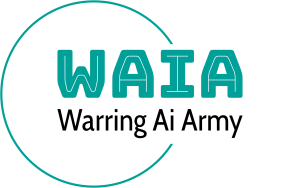
WE ARE DETERMINED TO ADVANCE THE TECHNOLOGY OF THE PRESENT, WHICH IS THE FUTURE OF THE PAST, AND TO ACCELERATE TIME…
Warring Artificial Intelligence Army (Warring AI Army)
- Fully Autonomous UNMANNED AERIAL VEHICLE SOFTWARE
- Fully Autonomous UNMANNED MARINE VEHICLE SOFTWARE
- Fully Autonomous UNMANNED LAND VEHICLE SOFTWARE
The software kit we are developing, which will individually empower air, sea, and land vehicles with autonomous capabilities and bring them to a stable release version, will be elevated to the status of an ARTIFICIAL INTELLIGENCE ARMY to be deployed in the DEFENSE INDUSTRY, strengthening our country’s power in these domains.
This engineering product, designed to be fully AI-driven yet open to external command, will enable these vehicles — capable of independent movement and operations across different environments — to unite towards a single target and command one another.
Border security will be maintained 24/7 through extensive area surveillance by air, sea, and land platforms in these three different modes.
When needed, or under mandatory conditions, these systems — equipped with intercommunication abilities — will also be able to take over tasks from one another or act in coordinated operations.
All processors and control mechanisms of the UNMANNED AERIAL, MARINE, and LAND vehicles we detailed will be developed using fully domestic resources and engineers from our country, alongside Ukrainian engineers who have gained experience at globally renowned aerospace companies such as Antonov.
Our first mission is to establish an army of unmanned aerial, marine, and land vehicles capable of decision-making and action with fully integrated artificial intelligence, preparing for the future.
There is no doubt that unmanned systems and artificial intelligence, which are indispensable in today’s world, will continue to advance and evolve.
As a country, while we have made great progress in mechanical technologies for the defense industry, we have also embraced the mission of advancing in software technologies.
At this point, we decided to develop this project to both minimize foreign dependency and to take one more step toward readiness for the future.
UNMANNED AERIAL VEHICLE SOFTWARE (Flight Controller)
We will enhance the autonomous capabilities of unmanned aerial vehicles (UAVs) on an individual basis.
Unfortunately, despite our wish to avoid it, we face unavoidable threats in the field of defense. The mechanical achievements of UAVs in our country have reached a level that fills us with pride.
It is evident that our technologies are at a very high standard both mechanically and electronically.
With the kit we are developing, we aim to further elevate the software capabilities of UAVs.
Based on our past experiences and findings, we have identified significant deficiencies in flight control boards and autonomous capabilities, along with a high degree of foreign dependency in this area.
Our primary mission is to eliminate this dependency by producing 100% LOCAL & NATIONAL HARDWARE AND SOFTWARE components.
Accordingly, we have defined our second mission as not only manufacturing a CLOSED-LOOP MICROPROCESSOR-BASED FLIGHT CONTROLLER BOARD but also developing the ROS (Robotic Operating System) software that the processor will utilize.
In line with these objectives, we aim to prevent the importation of UAV software for domestically produced or exported vehicles and ensure full compatibility with our secure and national technologies.
UNMANNED MARINE VEHICLE SOFTWARE (Swimming Controller)
Following the configuration of two different options — underwater or surface operations — we will enhance and develop the autonomous capabilities of unmanned marine vehicles, similar to aerial vehicles.
Although marine vehicles currently remain overshadowed by aerial vehicles, we foresee that their importance will significantly increase in the future.
Therefore, we will design our software kit to be compatible with both underwater and surface marine vehicles.
We define two main missions for unmanned marine vehicles individually:
Enabling underwater and surface vehicles to communicate and coordinate with each other.While defense remains the priority, we will also make these systems suitable for search and rescue operations using laser, acoustic, vibration, and imaging scanning techniques, particularly for underwater missions.
UNMANNED LAND VEHICLE SOFTWARE (Walking Controller)
After completing the aerial and marine systems, we will also develop autonomous control for land vehicles, thus completing the third stage of our project and achieving our overall mission.
Provided that hardware compatibility is ensured, we aim to equip all types of land vehicles with movement and autonomous driving capabilities — initially for defense industry purposes, but also for civilian uses such as area scanning and detection when necessary.